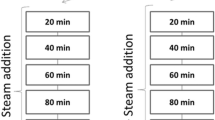Abstract
Glabrous or hairless canaryseed is a nutritional grain that could be a good addition to the diet if approved as a novel food. To assess the impact of thermal treatment on its digestibility; raw, roasted or boiled flours prepared from three different varieties of glabrous canaryseed were subjected to in vitro gastrointestinal digestion conditions and the effect on protein electrophoretic profiles was examined using sodium dodecyl sulphate polyacrylamide gel electrophoresis (SDS-PAGE). Roasting was done by dry-heat in an oven at 176 °C for 12 min whereas boiling was done in water at 98 °C for 12 min. SDS-PAGE showed approximately twenty-five protein bands in the undigested raw flour with molecular masses (MM) ranging from <14 kDa to >97 kDa. The dominant proteins had low MM, between the ranges of ~57 to 12 kDa. Roasting markedly altered the protein electrophoretic profile with the appearance of large molecular weight aggregates. Canaryseed proteins were more easily digested after thermal treatment and under sequential gastric-duodenal conditions than under gastric or duodenal conditions alone. Furthermore, roasting appeared to have a greater impact on in vitro protein digestibility than boiling.




Similar content being viewed by others
References
Abdel-Aal EM, Hucl PJ, Sosulski FW (1997) Structural and compositional characteristics of canaryseed (Phalaris canariensis L.). J Agric Food Chem 45:3049–3055
Hucl P, Matus-Cadiz M, Vandenberg A, Sosulski FW, Abdel-Aal EM, Hughes GR, Slinkard AE (2001) CDC Maria annual canarygrass. Can J Plant Sci 81:115–116
AAFC (2009) Overview of the Canadian special crops industry 2009. http://www.ats.agr.gc.ca/can/4752-eng.htm. Accessed: 12 December 2012.
Abdel-Aal EM, Hucl P, Patterson CA, Gray D (2010) Phytochemicals and heavy metals content of hairless canary seed: a variety developed for food use. LWT - Food Sci Technol 44:904–910
Robinson RG (1978) Chemical composition and potential uses of annual canarygrass. Agronomy J 70:797–800
Abdel-Aal EM, Hucl P, Patterson CA, Gray D (2010) Fractionation of hairless canary seed (Phalaris canariensis) into starch, protein, and oil. J Agric Food Chem 59:7046–7050
Abdel-Aal EM, Hucl P, Miller SS, Patterson CA, Gray D (2011) Microstructure and nutrient composition of hairless canary seed and its potential as a blending flour for food use. Food Chem 125:410–416
Ma Z, Boye JI, Simpson BK, Prasher SO, Monpetitb D, Malcolmsond L (2011) Thermal processing effects on the functional properties and microstructure of lentil, chickpea, and pea flours. Food Res Intl 44:2534–2544
Aguilera Y, Benítez V, Mollá E, Esteban RM, Martín-Cabrejas MA (2011) Influence of dehydration process in castellano chickpea: changes in bioactive carbohydrates and functional properties. Plant Foods Hum Nutr 66:391–400
Kirbaşlar FG, Erkmen G (2003) Investigation of the effect of roasting temperature on the nutritive value of hazelnuts. Plant Foods Hum Nutri 58:1–10
Mandalari G, Adel-Patient K, Barkholt V, Baro C, Bennett L, Bublin M, Gaier S, Graser G, Ladics GS, Mierzejewska D, Vassilopoulou E, Vissers YM, Zuidmeer L, Rigby NM, Salt LJ, Defernez M, Mulholland F, Mackie AR, Wickham MSJ, Mills ENC (2009) In vitro digestibility of β-casein and β-lactoglobulin under simulated human gastric and duodenal conditions: a multi-laboratory evaluation. Reg Toxicol Pharmacol 55:372–381
Laemmli UK (1970) Cleavage of structural proteins during the assembly of the head of bacteriophage T4. Nature 227:680–685
Maleki SJ, Chung S-Y, Champagne ET, Raufman J-P (2010) The effects of roasting on the allergenic properties of peanut proteins. J Allergy Clin Immunol 106:763–768
Gerrard JA, Brown PK, Fayle SE (2003) Maillard crosslinking of food proteins II: the reaction of glutaraldehyde, formaldehyde and glyceraldehyde with wheat proteins in vitro and in situ. Food Chem 80:35–43
Ee KY, Zhao J, Rehman A-U, Agboola S (2013) Effects of roasting on the characteristics of Australian wattle (Acacia victoriae Bentham) seed and extracts. Intl J Food Prop 16:1135–1147
Lehninger AL (1982) Principles of biochemistry. Worth Publishers, New York
Fu TJ, Abbott UR, Hatzos C (2002) Digestibility of food allergens and nonallergenic proteins in simulated gastric fluid and simulated intestinal fluid: a comparative study. J Agric Food Chem 50:7154–7160
Bannon GA (2004) What makes a food protein an allergen? Curr Allergy Asthma Reports 4:43–46
Acknowledgments
This project was funded by Canaryseed Development Commission of Saskatchewan. The authors would like to thank Ms Nancy Raymond and Ms Sabine Ribéreau, of Agriculture and Agri-Food Canada, for their assistance.
Conflict of Interest
The authors declare that they have no conflict of interest.
Author information
Authors and Affiliations
Corresponding author
Rights and permissions
About this article
Cite this article
Rajamohamed, S.H., Aryee, A.N.A., Hucl, P. et al. In vitro Gastrointestinal Digestion of Glabrous Canaryseed Proteins as Affected by Variety and Thermal Treatment. Plant Foods Hum Nutr 68, 306–312 (2013). https://doi.org/10.1007/s11130-013-0374-9
Published:
Issue Date:
DOI: https://doi.org/10.1007/s11130-013-0374-9




